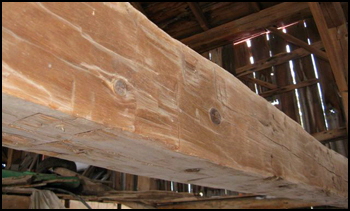|
Responsible Tolerance
While working with antique barn frames and vintage lumbers you will find that there are certain unique characteristics of these woods that you don’t find in new lumbers. The lack of uniformity in size, checks, color variation, old nail holes, knotches and mortise holes, and even twists in the timbers are all part of aged barn woods, and actually work together to comprise much of their charm and appealing colonial character.  Hand hewn timbers are a great example of this. Once whole trees, they were fashioned into usable barn timbers with broad axes and adzes. Take a close look and you will see all the irregular ax marks and wood chip cavities that our early barn builders left when they crafted these timbers. These early craftsmen had such great building skills and tenacity. I never cease to be amazed. Even with their great skills it is not unusual to find one end of these barn timbers to be significantly larger than the other end, perhaps even an inch or so. Each timber was more or less hand carved and, as such, has great variation. Hand hewn timbers are a great example of this. Once whole trees, they were fashioned into usable barn timbers with broad axes and adzes. Take a close look and you will see all the irregular ax marks and wood chip cavities that our early barn builders left when they crafted these timbers. These early craftsmen had such great building skills and tenacity. I never cease to be amazed. Even with their great skills it is not unusual to find one end of these barn timbers to be significantly larger than the other end, perhaps even an inch or so. Each timber was more or less hand carved and, as such, has great variation.
One must also consider that when these barns were constructed the timbers were usually mostly green and not seasoned. When the barns were erected and "air dried" over the next several years, the timbers shrank, twisted, checked, etc., and many of what was once a very tight "perfect" joint is now open and gapped. But yet even with all these imperfections and irregularities, these hand crafted timbers fit together perfectly to create a structurally strong barn frame and look completely harmonious when you view the barn as a whole.
We believe it is important to remember the above when rebuilding barns and converting them into other uses, especially living spaces of one form or another. Years ago I coined the phrase “responsible tolerance" in an attempt to communicate to our carpenters the importance, both financial and aesthetical, of attempting to maintain a consistent overall level of workmanship and style that the existing barn possesses. If you try too hard to impose “regularity and perfection” on irregular lumber, you will end up working against yourself - like trying to put a square peg in a round hole.  The end result of this kind of approach may create all sorts of unnatural and contrived looking details. For example, trying to do a 45 degree miter on window trim using weathered barn wood that is not all the same size, thickness, or level of weathering. It is very difficult and time consuming, and you usually end up seeing many fresh chisel marks and awkward looking seams between the mitered corners. The end result of this kind of approach may create all sorts of unnatural and contrived looking details. For example, trying to do a 45 degree miter on window trim using weathered barn wood that is not all the same size, thickness, or level of weathering. It is very difficult and time consuming, and you usually end up seeing many fresh chisel marks and awkward looking seams between the mitered corners.
Over my years in construction I have also noticed a wide range of skills, experience, and personal tolerances that individual carpenters and craftsmen brought to the table in their work. On the one end of the spectrum was what I call the “neurotic carpenter” who had to have everything perfect in order to sleep at night. They usually had lots of very sharp chisels in their tool bag and several micrometers. When working with all the irregularities of reclaimed vintage lumbers, this kind of perfectionism was often very time consuming and expensive, and many times their work looked too perfect and out of place with the overall style and nature of the barn itself.
This does not mean sloppy work of course, just intelligent work, so that you get the best possible finished product for the best possible costs. This is what “Responsible Tolerance” is all about and we have tried to apply this strategy to every aspect of the barn home conversion to keep the finished project harmonious and tasteful and, perhaps equally important, cost effective and affordable.
|